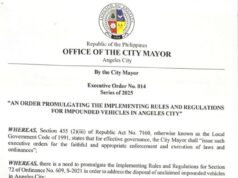“The P24 wage hike includes the integration of the workers’ old P10 cost of living allowance (COLA) into their basic pay and the granting of fresh P14 COLA,” Elizabeth Teves, secretary of the Regional Tripartite Wage and Productivity Board (RTWPB), told Punto. The last pay hike in Central Luzon was on June 16, 2008.
Teves explained that the right computation of the minimum wage increase should include both the integration of the former COLA into the basic pay of workers, plus the new COLA.
“In the computation of 13th month pay and other benefits for the workers, however, only the basic pay is used as parameter,” she added.
While the official computation of the new wage increase is P24, the wage earners would have only the P14 COLA as actual addition to their minimum daily pay.
The new Wage Order No. 15 stressed that “upon the effectivity of this wage order, the P10 cost of living allowance under Wage Order No. 14 shall be integrated into the basic pay, while a new COLA of P14 per day shall be granted to all minimum wage earners in the region.”
The new wage rates are to take effect 15 days from its publication in a newspaper of general circulation in Central Luzon.
Wage Order No. 15, however, also noted that the initial demand for minimum pay hike filed in Central Luzon by the Mitsumi Workers’ Union was P75 per day.
“After a study of the socio economic condition in the region and deliberations on the results of sectoral consultations and public hearing, the board deemed it necessary to provide workers immediate relief from the rising costs of living, taking into account the interests of both labor and management as well as the continued and sustained viability of business and industry in Region 3,” the wage order said.
In all six provinces of Central Luzon, except Aurora where minimum wage has always been lower, the minimum wage earners in non-agricultural firms with assets of more than P30 million will get P316 per day, while those in firms with less than P30 million assets are to get P308.50.
Minimum wage earners agricultural workers in plantations are to bet P286 daily wage, while agricultural non-plantation workers will be entitled to P270 wage.
Workers in hospitals with a capacity of 20 beds are to get P307, while those in smaller hospitals will have P 292 as minimum wage. In the retail and service sector with 16 or more workers, the wage earners are entitled to P305 daily wage, while those working for firms with less than 16 personnel are to receive P291.
Handicraft and cottage industry workers are not entitled to P270 daily minimum pay.
In Aurora province, non-agricultural workers are entitled to P265 minimum daily wage. Agricultural workers in plantations are to get P250 daily, while their counterparts in non-plantation jobs are entitled to P230.
Retail and service firms with no more than 10 workers should pay their minimum wage workers P187 daily, while those employed in cottage industry and handcraft will be entitled to P238.
The RTWPB said the wage order is based on the assumption of eight working hours per day even as “all workers paid by results, including those who are paid on piecework, ‘takay’, ‘pakyaw’ or task basis shall be entitled to receive the prescribed increase in this order per eight hours a day, or a proportion thereof for working less than eight hours.”
It also noted that “the minimum wage rate of apprentices and learners shall in no case be less than 75 percent of the prescribed minimum wage rate.”
The new wage order also provided room for exemption from coverage, including retail and service establishments employing not more than 10 workers at the time of the publication of the wage order.
Firms can also file for exemption if they could be classified as “distressed establishments” under the law, or are” garments exporting firms, including indirect exporters with at least 50 percent export sales and with forward contracts with their foreign buyers or principals entered into on or 12 months before the effectivity of this wage order.”



